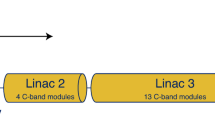Abstract
A simple technique is proposed to modulate the output radiation power in a free-electron laser (FEL) oscillator that allows the average radiation power to be adjusted smoothly, and short (as brief as 35 μs) radiation macrobunches to be obtained. It is based on the periodic shift of the electron bunch phase with respect to that of an FEL radiation bunch stored in the optical cavity, resulting in lasing suppression. The phase shift frequency required to suppress lasing is relatively low and does not change the electron bunch repetition rate appreciably. A computer-based test bench is created to demonstrate the feasibility of the proposed technique. The test bench contains standard CAMAC blocks: a G0609 modulator timer and a G0601 clock generator. The electron bunch phase is shifted via programmable skipping of the reference frequency periods used to start the current modulator in the electron gun. The skipping is controlled by a computer program operating in the real-time mode. The clock generator is used to send synchronization signals to the radiation user’s equipment. The test bench is tested via EPR spectroscopy with a temporal resolution that allows the duration of the generated macrobunches to be estimated.







Similar content being viewed by others
REFERENCES
Shevchenko, O.A., Arbuzov, V.S., Vinokurov, N.A., et al., Phys. Proc., 2016, vol. 84, p. 13.
Kuzmin, A.V., Shevchenko, O.A., and Vinokurov, N.A., Nucl. Instrum. Methods Phys. Res., Sect. A, 2005, vol. 543, no. 1, p. 114.
Kubarev, V.V., Quantum Electron., 2009, vol. 39, no. 3, p. 235.
Veber, S.L., Tumanov, S.V., Fursova, E.Y., et al., J. Magn. Reson., 2018, vol. 288, p. 11.
Ovcharenko, V.I., Maryunina, K.Y., Fokin, S.V., Tretyakov, E.V., Romanenko, G.V., and Ikorskii, V.N., Russ. Chem. Bull., 2004, vol. 53, p. 2406.
Veber, S.L., Fedin, M.V., Maryunina, K.Y., et al., J. Phys. Chem. A, 2013, vol. 117, p. 1483.
ACKNOWLEDGMENTS
This work was supported by the Russian Science Foundation, project nos. 14-50-00080 (design and creation of the test bench) and 17-13-01412 (test experiments with modulated radiation).
Author information
Authors and Affiliations
Corresponding author
Additional information
Translated by E. Smirnova
About this article
Cite this article
Shevchenko, O.A., Salikova, T.V., Tararyshkin, S.V. et al. A Computer-Based Test Bench for Modulating Terahertz FEL Radiation Power. Bull. Russ. Acad. Sci. Phys. 83, 159–162 (2019). https://doi.org/10.3103/S1062873819020266
Published:
Issue Date:
DOI: https://doi.org/10.3103/S1062873819020266




